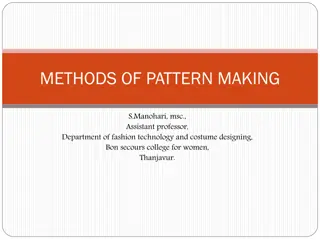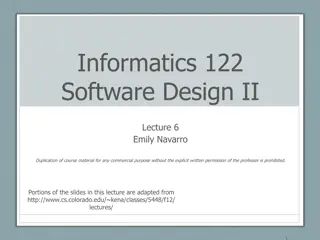Understanding Advanced Object-Oriented Design and the Strategy Pattern
Delve into the intricate world of Object-Oriented Design (OOD) with a focus on the Strategy Pattern. Explore the fundamental principles of OOD, such as encapsulation, abstraction, and the Single Responsibility Principle. Discover how objects interact through messages and how to ensure each class has a single responsibility. Learn how to apply these concepts in a practical scenario involving mapping nearby friends in an object-oriented manner.
Download Presentation

Please find below an Image/Link to download the presentation.
The content on the website is provided AS IS for your information and personal use only. It may not be sold, licensed, or shared on other websites without obtaining consent from the author. Download presentation by click this link. If you encounter any issues during the download, it is possible that the publisher has removed the file from their server.
E N D
Presentation Transcript
Advanced OOD and the Strategy Pattern 1
In our last episode (It was all about Object-Oriented Design) 2
A Concise Theory of Object-Oriented Object represents a thing person, car, date, (not two things, not thing) Object responds to messages (method calls) Things it does to itself (SRP) That is, other objects ask the object to do something to itself Objects are opaque Can t see each others data/vars Messages (calls) are only way to get things done 3
A Concise Theory of Object-Oriented, II Because objects are completely opaque, we don t need to know what s really inside them Each car object could be implemented with its own unique code If two cars behave the same, then really should have same code Otherwise would violate DRY And a huge amount of coding work So all cars are made from a common car template Template = class The car template is not a car, it s a blueprint for a car Helps satisfy DRY 4
Single Responsibility Principle Single Responsibility Principle (SRP) Each class should be responsible for one thing (capability, entity, computation, etc.) Can phrase this as mind your own business object do its own calculations object should not do calculations for another Easy to violate this because objects need to be connected to one another e.g., Events happen as part of Dates
Object-Oriented Design, wuggy style As a user I want see my nearby friends on the map So that I know who to contact for a spontaneous meet-up 1. Identify the things me (previous user story) friends, friend map (previous, built-in) Identify the messages me.logged-in (previous) friend.location-known friend.location friend.online friend.near(me) friend.image Assemble into classes Right things call right messages (TBD) Given I am logged in And my location is known When my friends are online And my friends location is known And my friends are near me Then I see them on the map 2. class Friend { Location location(); // null > not-known boolean online(); Bitmap image(); } class Friends implements Iterable<Friend> { Friends online(); Friends locationKnown(); // > online? } 3. 4. 6
Object-Oriented Typing Theory of Object-Oriented, III 7
Typing and Subtyping: is a In Object-Oriented, it s all about behavior A particular behavior is described by a type Mammalian behavior is the Mammal type Tiger behavior is the Tiger type Because a Tiger always behaves like a Mammal, we say that Tiger is a subtype of Mammal Feline is asubtype of Mammal House Cat is asubtype of Feline s Subtype c means all s salways act like a c but not all c sact like an s All Felines are Mammals But not all Mammals are Felines Means that Feline object will always work wherever a Mammal is needed Mammal Feline Canine Tiger House Cat 8
Typing and Subtyping: is a (II) Feline a subtype of Mammal means Mammal a supertype of Feline A supertype variable can hold values of any of its subtypes void petFur(Mammal m) { int coarseness = m.furValue(); } Use of a supertype variable like Mammal allows all current and future subtypes of Mammal to be petted petFur will work for Canine subclass Dog when it is added We say that petFur is open for extension Mammal Feline Canine Tiger House Cat 9
Three Ways to Declare Subtype in Java Mammal Subclass a class classMammal { } class Feline extendsMammal { } Feline is a subtype of Mammal Feline gets all of Mammal s implementation (can override) Feline Canine Tiger House Cat Subclassing abstract class is similar Can t new an abstract C b/c not all methods implemented abstractclassMammal { } class Feline extendsMammal { } Feline must implement missing methods of Mammal Abstract class asserts I m a category of thing, not a real thing Interface has no methods implemented Like a totally abstract class interface Cuddly { } class HouseCat extends Feline implements Cuddly { } 10
More on Interfaces A class can extend just one superclass But a class can implement multiple interfaces interface Cuddly { } interfaceSpotted { } class Tabby extends Feline implements Cuddly, Spotted { } Means interfaces are much more flexible Mammal Can mix in all the supertypes you want Feline Canine Not just a tree of types anymore Spotted Cuddly Bengal Tiger Tabby 11
More on Interfaces, II Not all classes represent a unique type Maybe want another impl of same thing for performance, say Consider two possible impl s of Set class TinySet implements Set { /* linked list */ } class BigSet implements Set { /* uses hard disk */ } Identical interfaces, input/output behavior > same type One faster for tiny sets, the other faster for big sets Use interfaces for implementation alternatives Since TinySet real subtype, extends would be misleading Since no shared implementation, extends would be misleading 12
How represent Feline (and Why)? A. Class B. Abstract Class C. Interface D. Extends Abstract class allows reusing some common implementation among Felines, and yet cannot be new d (instantiated). Interface is a reasonable answer, too, as the sharing might not be too great. Mammal Feline Canine Tiger House Cat 13
A Few Things to Remember Avoid subclassing (extends) Use when you have a real type hierarchy And when you are lazy and want to share method implementations But rare that non-leaf classes (like Mammal) can be instantiated (new d) Subclassing abstract superclass is better Captures is-a relationship of real type hierarchy Purpose is still to borrow method implementations But asserts that non-leaf class can t be new d Interfaces are the bomb The most flexible When you have multiple supertypes, or When the subclasses are just implementation alternatives 14
Interfaces are Central to Java Java Collections Framework Interface Collection methods like add(Object) & contains(Object) interface List extendsCollection interface Set extendsCollection Wherever Collection variable appears, allows for a a ListArray or HashSet, etc. Requires no particular implementation Super-flexible code 15
Strategy Pattern Composition + Delegation + Interfaces 16
Car Description: Whats Wrong? abstract class CarDesc { Color paintColor(); int wheelbase(); int tireSize(); boolean tirePerf(); String tireSeason(); /* should be enum */ } A. CarDesc and maybe SmallCar should be an interface B. All these classes should implement a Tire interface C. KiaSoul should have a Tire field As implemented, KiaSoul only allows one set of values for tire behavior. By adding a Tire field and delegating to its function, then all sorts of tires will be possible. (See next slide.) abstract class SmallCar extends CarDesc { } class KiaSoul extends SmallCar { int tireSize() { return 165; } boolean tirePerf() { return false; } String tireSeason() { return All ; } A is an OK answer, but it s not nearly as big a deal as the inflexibility of the tire methods. 17
Strategy Pattern Design abstract class CarDesc { } abstract class SmallCar extends CarDesc { } class KiaSoul extends SmallCar { Tire tires; int tireSize() { return tires.size(); } boolean tirePerf() { return tires.perf(); } String tireSeason() { return tires.season(); } composesTire ( has-a ) delegates to Tire (easy!) KiaSoul has Tires Delegates tire method impls to Tire Tire impl is reusable in other settings Can change at runtime: mySoul.changeTires(new DunlopSP()); 18
Strategy Pattern Design Tire should be a: abstract class CarDesc { } abstract class SmallCar extends CarDesc { } A. Class B. Abstract class class KiaSoul extends SmallCar { Tire tires; int tireSize() { return tires.size(); } boolean tirePerf() { return tires.perf(); } String tireSeason() { return tires.season(); } composesTire ( has-a ) C. Interface Why? We want to leave KiaSoul open to having all kinds of tires, and an interface is most flexible. An abstract class is OK, too, if you think there is a Tire type hierarchy with significant shared implementation. delegates to Tire (easy!) KiaSoul has Tires Delegates tire method impls to Tire Tire impl is reusable in other settings Can change at runtime: mySoul.changeTires(new DunlopSP()); 19
Strategy Pattern Design abstract class CarDesc { } abstract class SmallCar extends CarDesc { } _____KiaSoul_____ Tire tires_________ int tireSize() bool tirePerf() String tireSeason() <<interface>> _____Tire_____ int size() bool perf() String season() class KiaSoul extends SmallCar { Tire tires; int tireSize() { return tires.size(); } boolean tirePerf() { return tires.perf(); } String tireSeason() { return tires.season(); } _MichelinPilot_ _DunlopSP_ I m going to disagree strongly with the prior semester on this one. MichelinPilot and DunlopSP should be subclasses of Tire. Tire should not be an interface. The is a relationship clearly holds and acts like is clearly too weak. Just because methods aren t shared right at this second, doesn t mean that they won t be later. Design needs to be principled, not fit the moment. We shouldn t put to an interface, just because the present requirements require no methods. We certainly can envision plenty. We ll make a mess if we later need to add roll(), loseAir() , heatUp() , etc, methods, which would be implanted the same across all tires, and Tire is an interface not a base class. 20
Take-Aways Start thinking about objects Then think about types Then is a vs has a Then, consider the hierarchy Are behaviors re-implemented because they don t apply to all peer sub- types? Are behaviors appearing where they shouldn t, or doing things they shouldn t, by inheritance? Fix by overriding, if necessary Better idea: Can the behaviors be moved down? An intermediary added? Would pure abstract base classes be better served by interfaces [Java]? Same behaviors, but not a common implementation Behavior exhibited by other classes to which neither as a nor is a apply (just plain different classes) Consider is a vs has a and then, as a refinement, is a versus act like a 22






















